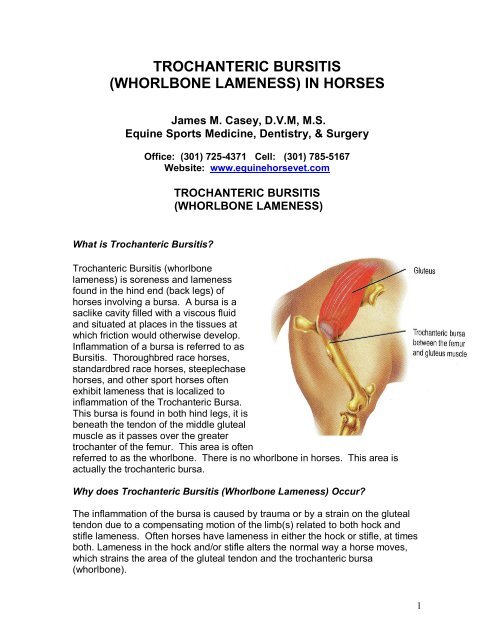Trochanteric Bursitis (Whorlbone Lameness) - Equine Veterinary ...
Trochanteric Bursitis (Whorlbone Lameness) - Equine Veterinary ...
Trochanteric Bursitis (Whorlbone Lameness) - Equine Veterinary ...
You also want an ePaper? Increase the reach of your titles
YUMPU automatically turns print PDFs into web optimized ePapers that Google loves.
TROCHANTERIC BURSITIS<br />
(WHORLBONE LAMENESS) IN HORSES<br />
James M. Casey, D.V.M, M.S.<br />
<strong>Equine</strong> Sports Medicine, Dentistry, & Surgery<br />
What is <strong>Trochanteric</strong> <strong>Bursitis</strong>?<br />
Office: (301) 7254371 Cell: (301) 7855167<br />
Website: www.equinehorsevet.com<br />
TROCHANTERIC BURSITIS<br />
(WHORLBONE LAMENESS)<br />
<strong>Trochanteric</strong> <strong>Bursitis</strong> (whorlbone<br />
lameness) is soreness and lameness<br />
found in the hind end (back legs) of<br />
horses involving a bursa. A bursa is a<br />
saclike cavity filled with a viscous fluid<br />
and situated at places in the tissues at<br />
which friction would otherwise develop.<br />
Inflammation of a bursa is referred to as<br />
<strong>Bursitis</strong>. Thoroughbred race horses,<br />
standardbred race horses, steeplechase<br />
horses, and other sport horses often<br />
exhibit lameness that is localized to<br />
inflammation of the <strong>Trochanteric</strong> Bursa.<br />
This bursa is found in both hind legs, it is<br />
beneath the tendon of the middle gluteal<br />
muscle as it passes over the greater<br />
trochanter of the femur. This area is often<br />
referred to as the whorlbone. There is no whorlbone in horses. This area is<br />
actually the trochanteric bursa.<br />
Why does <strong>Trochanteric</strong> <strong>Bursitis</strong> (<strong>Whorlbone</strong> <strong>Lameness</strong>) Occur?<br />
The inflammation of the bursa is caused by trauma or by a strain on the gluteal<br />
tendon due to a compensating motion of the limb(s) related to both hock and<br />
stifle lameness. Often horses have lameness in either the hock or stifle, at times<br />
both. <strong>Lameness</strong> in the hock and/or stifle alters the normal way a horse moves,<br />
which strains the area of the gluteal tendon and the trochanteric bursa<br />
(whorlbone).<br />
1
What are the signs?<br />
Pain may be seen when pressure is applied over the greater trochanter. Also,<br />
when observing how the horse places its hind foot on the ground when jogging.<br />
The inside or medial wall of the hoof comes in contact with the ground before the<br />
outside or lateral wall of the hoof touches the ground. In some cases an<br />
examination of the shoes will note the inside of the hind shoe is worn more than<br />
on the outside of the hind shoe.<br />
Diagnosing?<br />
Treatment of <strong>Trochanteric</strong> <strong>Bursitis</strong> (<strong>Whorlbone</strong> <strong>Lameness</strong>)<br />
The old time remedy was to inject counter irritants<br />
such as iodine into and around the trochanter<br />
bursa. Now, there are more effective treatments<br />
available to replace this procedure. Injection of the<br />
trochanteric bursa with low dose cortical steroids<br />
and hyaluronic acid is a very effective treatment.<br />
This practitioner prefers to use Betamethasone as<br />
the steroid of choice along with a high<br />
molecular weight hyaluronic acid when<br />
injecting the trochanteric bursa. Platelet<br />
Rich Plasma and Stem Cells are also<br />
useful and indicated as an injection<br />
Diagnosis of trochanteric bursitis<br />
(whorlbone lameness) is done by<br />
physical examination and<br />
observation. Diagnostic aids<br />
include Infrared thermography,<br />
which will reveal an increased<br />
thermal gradient (temperature)<br />
directly over the greater trochanter<br />
of the femur. Also, a diagnostic<br />
nerve block using local anesthetic<br />
directly over the bursa will<br />
differentiate this bursitis from other<br />
conditions.<br />
2
treatment for trochanteric bursitis (whorlbone lameness). Strict aseptic technique<br />
should always be used when injecting the trochanteric bursa.<br />
Topical application of medical grade DMSO and cortisone (a capsaicin based<br />
product preferred) massaged around the area of the trochanteric bursa will aid in<br />
the reduction of inflammation and pain.<br />
Remember, soreness in the trochanteric bursa (whorlbone) is usually secondary<br />
to lameness in the hocks and stifles. When treating trochanteric bursitis<br />
(whorlbone lameness) the contributing factors, including soreness in the hocks<br />
and/or stifles, need to be addressed.<br />
Managing <strong>Trochanteric</strong> <strong>Bursitis</strong> (<strong>Whorlbone</strong> <strong>Lameness</strong>)<br />
In most cases of trochanteric bursitis, the horse will respond to therapy within a<br />
few weeks. However, when training is resumed, constant physical therapy and<br />
maintenance injections of cortical steroids and hyaluronic acid may be needed.<br />
<strong>Equine</strong> Sports Medicine, Dentistry, & Surgery<br />
James M. Casey, D.V.M, M.S.<br />
<strong>Veterinary</strong> Practitioner and Surgeon<br />
Practicing in the MidAtlantic States & Florida<br />
(MD, VA, DE, PA, NJ, GA, KY, FL)<br />
Consults Nationally and Worldwide<br />
Office: 3017254371 Cell: 3017855167<br />
Email: casey@us.net Website: www.equinehorsevet.com<br />
3


